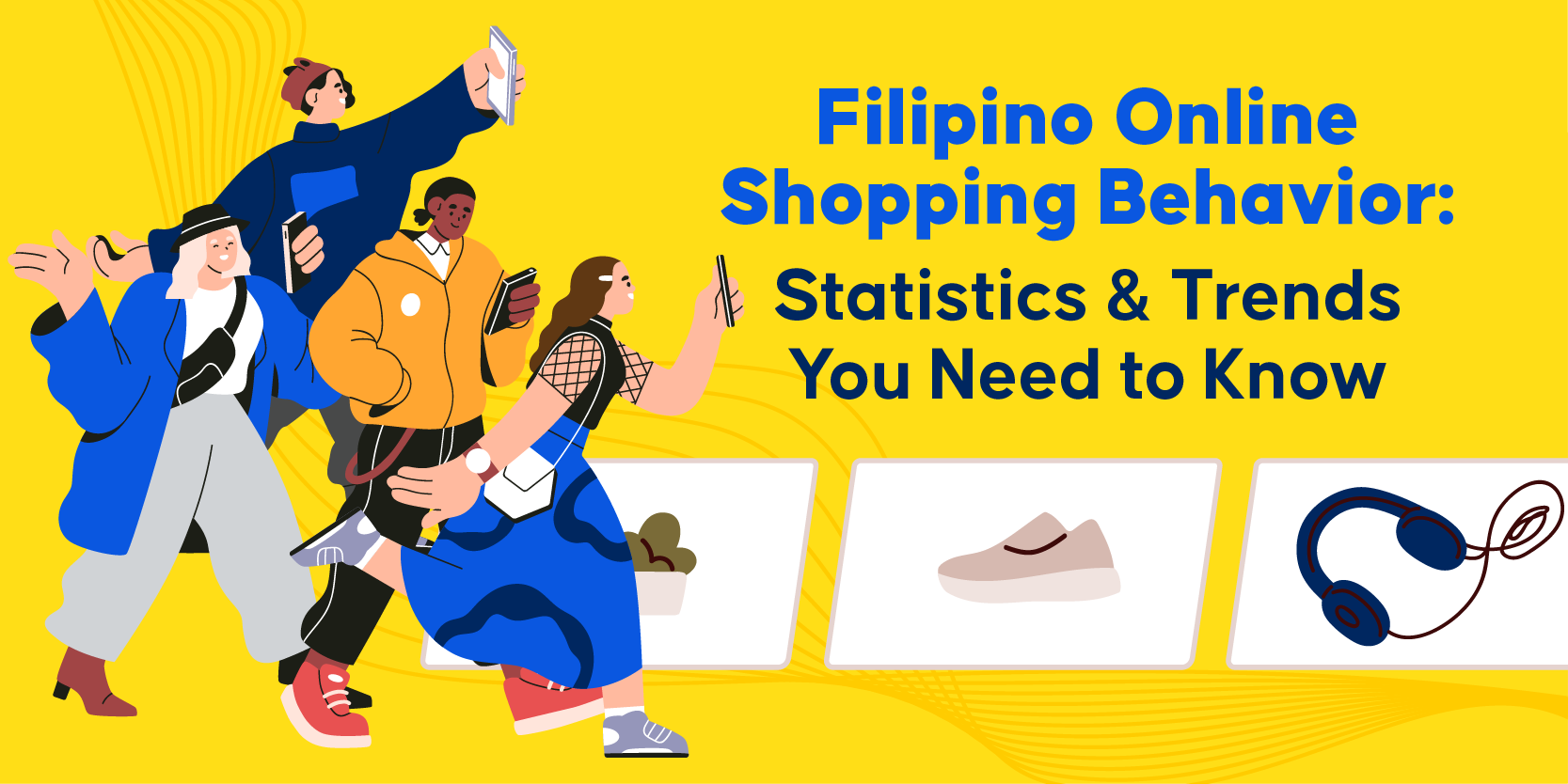Struggling to reach and convert online buyers in the Philippines?
Contact us today and learn how we can boost your local ecommerce efforts!
Over the past couple of years, online shopping experienced meteoric growth worldwide, and it’s here to stay. The International Trade Administration reported that ecommerce’s global retail sales went from 13.6% of the market share to 18% in the first year of the pandemic.
With more people embracing online shopping, businesses around the globe are rethinking their retail strategies and ramping up their digital presence. The Philippines is no exception to this trend. Despite returning to near pre-pandemic levels, online shopping in the Philippines continues to grow, but that means so is the competition.
If you want to rise above your competitors or get a head start in the industry, you need to understand Filipino online shopping behavior to help you strategize your next move.
Read on, as this infographic lists everything aspiring and veteran online retailers need to know about ecommerce in the Philippines.

An Overview of the Philippine Ecommerce Market
Achieving success in ecommerce starts with understanding where the market is currently. Here are some online shopping statistics in the Philippines worth noting to help you strategize your brand’s next ecommerce efforts.
Demographics
To get started, you should know the demographics of your shoppers and your competition. This information can help you target your marketing and sales efforts more accurately.
Millennials are the main drivers of ecommerce.
The younger generations will always lead the charge when embracing new things, which holds for ecommerce.
According to research, 52% of Filipino online shoppers are in the 25-34 age range. If you combine them with the 18-24 shoppers, they make up nearly 80% of all shoppers. Millennials likely edge out Gen Z due to adulthood’s increased spending power and responsibilities.
Adapting your sales and marketing initiatives to target these age groups can significantly improve the number of customers your business receives.
72% of Filipino online shoppers are female.
Records show that Filipinas heavily outspend their male counterparts when it comes to ecommerce. One potential reason for this significant disparity is that women generally use social media more, a primary vehicle for ecommerce in the Philippines.
If you want to target female customers, research which avenues of promotion are more likely to reach the targeted audience. For example, 75% of Pinterest’s users are female, so ads on the site may perform better.
38% of all ecommerce transactions occur in Metro Manila.
Despite efforts from the government and ecommerce platforms, sales in Philippine provinces are still catching up. Of the regions, Cavite has the next largest customer base at 9%, Cebu has 6%, and Pampanga, Davao, and Rizal have 3% each.
While it makes sense for you to focus on selling to the largest audience, it might be wise to begin selling to provinces. Because they’re underutilized, you might find an eager audience to receive your business.
Majority of independent online sellers have finished high school.
Most online sellers have a high school diploma, which emphasizes the role of knowledge in ecommerce. While a degree isn’t everything, schooling may equip you with the skills and tools to better understand and utilize the capabilities of technology.
Of course, no amount of schooling can beat practical experience, so don’t let this fact discourage you from building an ecommerce store. After all, the world is full of highly successful multi-millionaires who struggle with formal education.

Shopping Habits
Now that you know your audience base, it’s time to determine consumer buying behavior towards online shopping in the Philippines and the factors affecting them.
Filipinos are on social media 10 hours a day, seven days a week.
There’s a reason why people call the Philippines the social media Capital of the World. Advertising and selling on social media are so effective because many Filipinos are already on these platforms—and businesses know this, which is why it’s very rare for a company to have no social media presence.
With this information in mind, it would help if you capitalized on Filipinos’ borderline obsession with social networking sites to achieve your business’s full potential.
Mega Sale Days affect consumer shopping behavior.
Like retail stores, ecommerce platforms hold regular site-wide sales called Mega Sale Days, which Filipinos love. In fact, 76% of year-end shoppers enjoy discovering items they weren’t actively looking for. In particular, near-holiday sales like 10.10, 11.11, and 12.12 events significantly boost fashion, food, and health and beauty purchases.
Offering discounts during these sales is a great way to pull interested customers who are already looking for great deals.
86% of Filipino online shoppers pay via cash on delivery.
Cash is still the most popular payment method for online shoppers, specifically in the Philippines. The other payment methods, in descending order, include mobile wallets, mobile payment apps, credit and debit cards, and bank transfers.
It would be best to offer a variety of payment methods to minimize friction and last-minute cancellations.
92% of Filipino online shoppers prefer using their smartphones when transacting.
Mobile is far and away the most frequently used device for Filipinos of all ages. This figure will likely only grow as phone availability increases. To use this, ensure that you optimize your product listings and advertisements for phone screen sizes.
Ecommerce Sales
Now for the bigger picture: how is the Philippine ecommerce market performing? Here are some facts and figures you need to know about the industry in the country.
The Philippines has had the highest online shopping growth in Southeast Asia (SEA) over the pandemic.
In the country, 54% of consumers made their first online purchase during the pandemic, and 73% of new online shoppers plan to continue buying online after restrictions lift. Even from its lower starting area, the country quickly catches up to its neighbors within the SEA region.
The Philippine ecommerce market sales are projected to hit $24 billion in 2025.
After the initial shock, online shopping in the Philippines continues to grow steadily, hampered only by the need for more technological and financial infrastructure in more remote areas. As the market overcomes these challenges, you can expect even faster growth in the near future.
Shopee has the highest monthly traffic estimate in the Philippines, with 74.91 million.
Of all the ecommerce platforms, Shopee is the most popular, with almost 75 million web visitors monthly. Facebook Marketplace is a close second, with Lazada and Carousell trailing behind. Cross-posting on these platforms will expand your reach and close more deals for your brand.
Electronics are the most spent items in the ecommerce space at $6.85 billion.
Across all ecommerce platforms, electronic products outperform the next type (personal and household care products) by more than double. It might be challenging to carve a space in the electronics market, so don’t think you need to sell what everyone else is selling.
Emerging Online Shopping Trends in the Philippines
Based on the available ecommerce statistics for businesses, below are a few emerging digital retail trends in the Philippines for 2023 your organization can explore!
Rise of more value-centric customers
As society becomes more conscious of social issues, more people buy from brands that reflect their values. In the Philippines, this trend expresses itself in Filipinos who purchase sustainable products and support smaller local businesses over large corporations.
More discerning buyers
With the growing number of businesses entering the online marketplace, Filipinos have a wider range of options, which has led to a greater emphasis on value. Because of this, retailers are forced to make their products less expensive or more unique to remain competitive.
Prioritization of customer service
Businesses recognize the need to prioritize customer service to retain customers and keep up with other services. Customer service is a critical battleground where sellers offering similar products can differentiate themselves by providing Filipinos with a seamless and tailored buying experience.
Expanded cashless payment options
The shift towards cashless payment options in the Philippines is gaining momentum, with digital wallets and other methods becoming increasingly popular. The convenience and safety these cash alternatives offers are the main reason businesses and the government push this transition.
Increased importance on delivery times
The convenience of online shopping is one of its largest draws, but slow and unreliable delivery is a speed bump for future growth. In response to this challenge, ecommerce platforms and online retailers partner with logistics companies to improve delivery capacities, speed, and reach.
Expansion into provinces
Businesses are recognizing the potential of the country’s provinces as an untapped market for online shopping. The drive towards improving delivery capacity is partially to gain a new customer base. However, there are many infrastructural challenges that ecommerce platforms and sellers need to overcome.
Implementation of new technologies
With the widespread use of mobile devices in the Philippines, ecommerce companies are experimenting with ecommerce tools like artificial reality (AR) and artificial intelligence (AI) to improve the customer experience. AR allows customers to visualize products before purchasing. AI has many potential applications, too, including data analysis and automation.
The State of This Digital Nation
The online shopping industry in the Philippines is experiencing tremendous growth and showing no signs of slowing down anytime soon. In such a fast-paced market, ecommerce retailers must understand online shopping behaviors to improve their business strategies and operations and keep up with the rapid shifts.
If you want to elevate your brand in this increasingly digital nation, consider partnering with Spiralytics! We are a digital marketing agency offering top-notch pay-per-click advertising in the Philippines and other performance marketing support to bring your business into the spotlight and help you navigate today’s competitive online space!
Skip the guesswork in improving your digital marketing performance, and contact us today to get started!





